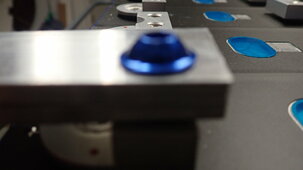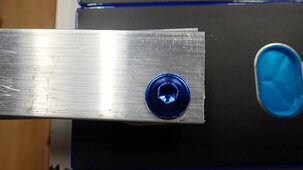I just started with the new two-hole-style terminals. I tried to get them in the single hole as I had many leftover parts I could have used. But they do not make them like that anymore. I preferred the single as it allowed me to set the height easily for the busbars and other components. Interestingly, my old busbars fit the hole spacing, but they are off-center. I plan only to drill one hole, hoping the parallel bars will help even the pressure across the series connectors. After I get one built, I should be able to offer a better option on it. Screws are already an issue as it's not easy to locally source aluminum m6 x 20mm screws.kromc5,
Nice work! A question. You have some pics showing complete systems using the single stud style terminals, and the start of a system using the twin hole style. I can get my cells in either style -- do you have any thoughts on the differences? I note that you only used 1 hole of the twin style.
Also, in the complete system, where you have 4 cells in parallel then series connected to the next 4, you not only connected both sets in parallel, but you series connected each pair of cells (rather than 1 or 2 jumpers to the next set of cells). I'm thinking that solution (but with one or 2 jumpers) as it has more flexibility, or a single plate (say 3" wide by 8" long) with all the holes drilled in it. More rigid (a down side) but much cleaner/simpler.
You are using an out of date browser. It may not display this or other websites correctly.
You should upgrade or use an alternative browser.
You should upgrade or use an alternative browser.
DIY Bus Bars from copper bar
- Thread starter GnrlPatton
- Start date
sailingharry
New Member
That brings up something I've been wondering about. On sailboats, with salt water, we use a lot of aluminum, and then stick in SS fasteners. It is a disaster, an adhesion suitable for space age connections. I've been wondering about SS fasteners in those terminals, but thinking maybe inside in a dry environment it would work. I've also been thinking that steel (or maybe plated steel) might be a better answer (less corrosion with aluminum, and rust might be a non-issue). But aluminum fasteners (if you can find them and they are strong enough) are a perfect solution.Screws are already an issue as it's not easy to locally source aluminum m6 x 20mm screws.
I would like to avoid using lubricants or anti-seize, if possible. But so far, everything I have found is not local, with estimated shipping times from mid-April to late May.That brings up something I've been wondering about. On sailboats, with salt water, we use a lot of aluminum, and then stick in SS fasteners. It is a disaster, an adhesion suitable for space age connections. I've been wondering about SS fasteners in those terminals, but thinking maybe inside in a dry environment it would work. I've also been thinking that steel (or maybe plated steel) might be a better answer (less corrosion with aluminum, and rust might be a non-issue). But aluminum fasteners (if you can find them and they are strong enough) are a perfect solution.
sailingharry
New Member
Amazon can help with fasteners!I would like to avoid using lubricants or anti-seize, if possible. But so far, everything I have found is not local, with estimated shipping times from mid-April to late May.
M6x30 delivered in no time flat: https://a.co/d/iRKaYhV
Or 20mm in pretty colors: https://a.co/d/5etPjuy
I think those colors are only anodizing, which is just aluminum oxide with dye added. So they are essentially "just aluminum."
but if you want studs to top with nuts, that could be harder. Perhaps buy 40mm and cut off the heads?
Still I wonder about the strength of aluminum fasteners. Granted, if they break off and you can remove the remains, it's not too horrible.
That is an amazing find. I bought the second one in your link for fitment testing a while back. I was worried about the anodizing and whether that itself could cause issues.Amazon can help with fasteners!
M6x30 delivered in no time flat: https://a.co/d/iRKaYhV
Or 20mm in pretty colors: https://a.co/d/5etPjuy
I think those colors are only anodizing, which is just aluminum oxide with dye added. So they are essentially "just aluminum."
but if you want studs to top with nuts, that could be harder. Perhaps buy 40mm and cut off the heads?
Still I wonder about the strength of aluminum fasteners. Granted, if they break off and you can remove the remains, it's not too horrible.
Attachments
How many amps do you draw in total?
Big inverters and eg electric galley?
The 1/4“ tinned copper bars are good for 300A continuous. I you are running a 3kw inverter plus rest of your boat you are above that.
I doubled them up as I am pulling 500A from 5,9kw inverter, so suggest to better get 20x10 or 25x8 tinned Cooper bars right away.
In a compression jig that’s fine. Drill the holes with 7mm driller for the m6 studs, this gives enough wiggle room for extensions of the cells.
Drilling copper is pita, predrill with a 3mm and take your time. The above busbars have too big holes because they were not drilled properly, only slightly oversize 6,5 or max 7mm holes. You have to really work precise here as the 304 cells have a small contact area too and you need every bit of it.
@12v 3KW is only 250A. The EVE304 cells are only rated to pull 1C of current (300A), the bus bars that come with them are perfectly fine.
You can get the busbars off Alliexpress and unless you have a machine shop it's not really worth making your own with how cheap you can get them.
I've made my own busbars from 1/4"x1" tinned copper stock from onlinemetals.com. With the 2 hole terminals it was a bit more work drilling the holes, but not too bad. My concern with this approach is lack of flexibility of these busbars. I was able to get cells lined up fairly well for a smaller battery bank (2p4S), but I gave up on this idea for a larger bank I am also building (2P8S). So I decided to order from aliexpress long busbars (that span 4 cells). It's a bit more expensive than making my own, but probably would work better in the end. Have you guys had any experience with these long busbars?
Last edited:
Daddy Tanuki
Solar Wizard
I realize this is a fairly old thread. But it is very close to my question, and the best I can find on the forum. Rather than starting a new, nearly identical thread, I'll post here.
I'm preparing to do a 3P4S build of 304Ah Eve with the new 2xM6 studs. Bus bars in general, and especially flexible, for these terminals are hard to find, expensive, and not available in configurations for larger paralleling configurations.
Like OP, this is going on a sailboat. I'll be building the pack in a tight box with modest compression, so hopefully no motion anywhere. Most of my connections will involve 6 cells, either with a long bar (6 terminals in a line) or with a short/wide bar (3 terminals down each side). Of course, each terminal is 2 screws, so double the number of holes.
I'll use copper, plated with lead-free solder. Copper will be sized appropriately for the loads (400A fuse on the bank, actual loads rarely over 300A), using the 30C column here https://www.copper.org/applications/electrical/busbar/bus_table1.html (so 1/8x1.5 or 3/16X1 for the long ones, and the wide ones are a complete non issue).
Has anyone had any negative outcome from using solid bus bars? I understand the "theory" about solid bars putting undue stress on the terminals, but what about "in practice?"
i think if you use a jig that restricts movement in relationship to the terminals, and you put some sort of plastic between the cells (and bottom) you will be fine unless you get into catastrophic sea conditions... and that is about all i can say, we all know the best made plans have nothing compared to the strength of mother nature
Similar threads
- Replies
- 2
- Views
- 294




